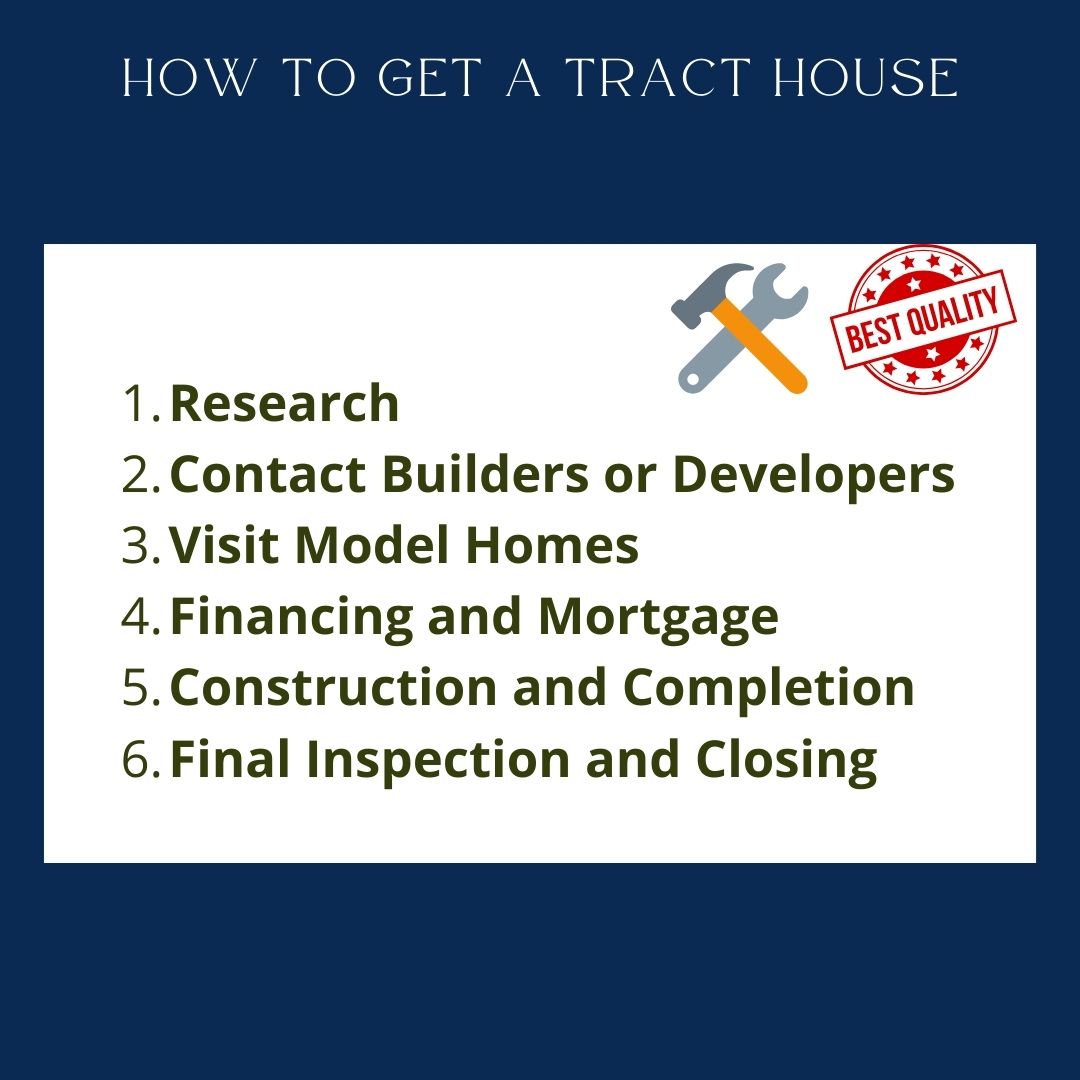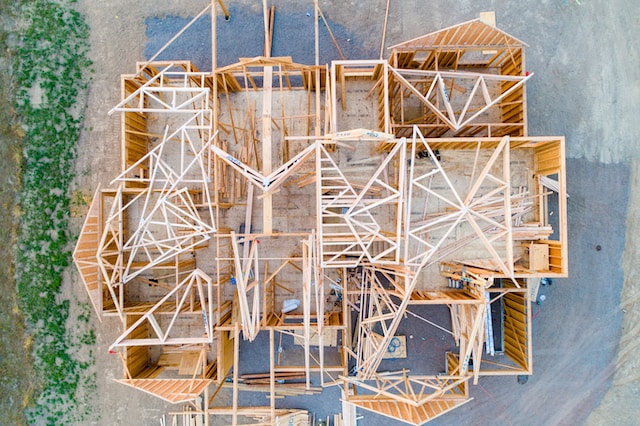What is a tract home? Let’s uncover the types, talk about the unique features of a tact house and bring out tract homes' pros and cons.

What Is A Tract House?
A tract house neighborhood refers to a residential development where the land is divided into smaller parcels and multiple houses with similar designs are constructed. If you follow the words literally tract house means “a house that is one of a number of very similar houses built on a tract of land”
Tract homes first appeared in the 1940s in response to the expanding demand for cheap housing. Builders used economies of scale to produce a large number of comparable homes quickly and affordably in order to fulfill the growing demand. Builders would buy many nearby properties and build the homes quickly using an assembly-line method
The restricted variety of architectural styles used in tract housing development allows workers to specialize in the particular knowledge and methods needed for those styles rather of having to go through the entire construction process again, which lowers labor costs. Because the homes are already completed, buying a tract home is simpler than buying a custom one because there are fewer decisions to make. Now, let us understand why and what are the advantages of affordable tract housing.
History of Tract Houses
Although tract homes have a long history dating back to the early 20th century, it wasn't until the post-World War II era that they really started to make a big impact on housing development.
Due to the inflow of returning soldiers and the expanding population following the end of World War II, there was an increase in demand for housing. Affordable housing choices were also required to accommodate middle-class families. Tract housing was developed in response to this demand as a way to supply mass-produced, inexpensive dwellings.
Construction of tract homes had a considerable rise in the 1950s and 1960s. On the fringes of cities, developers purchased vast tracts of land so they could create sizable housing developments.
The houses were often single-family dwellings, featuring simple designs, standardized floor plans, and affordable materials.
Tract housing developed further over time. As tastes evolved, the designs became increasingly varied, incorporating many architectural styles. Additionally, builders began to provide customers with greater possibilities for personalization, enabling them to add their own touches to specific areas of their homes. As we answered the question “what is a track home” let’s get with it further.

Photo by Breno Assis on Unsplash
Pros And Cons Of A Tract House
Here we come to the most interesting part, tract homes' pros and cons! Just like any other types of housing tract houses have their advantages and disadvantages. Some families find it the most suitable for their needs, some say that tract homes are not convenient in different ways. Let’s uncover everything!
Pros of a Tract House
- Affordability: When compared to custom-built homes or alternative housing options, tract homes are typically cheaper. Builders can gain economies of scale thanks to the uniform design and building process, which leads to lower prices that can be passed down to customers.
- Availability: The availability of tract homes is common in planned communities or housing complexes. Finding a home is often easy and quick because buyers can select from a variety of accessible models and lots.
- Amenities and Infrastructure: Tract housing complexes frequently include common infrastructure and services like playgrounds, community centers, parks, and perhaps even schools. These amenities improve the community's quality of life and offer convenience to the locals.
- Quick Construction: Tract homes can be constructed quite rapidly because they are based on pre-designed layouts and construction methods. In contrast to custom-built options, which can take several months or even years to finish, buyers can move into their new homes sooner as a result.
- Predictable Design: Buyers who like a certain style or layout may find tract homes appealing because they often adhere to a set design. Popular elements and contemporary conveniences that follow current dwelling trends are frequently incorporated into these designs.
Cons of Tract Homes
- Lack of Individuality: One of the primary critiques about tract homes is that they are not distinctive. It might be challenging for residents to exhibit their personality and personal taste because of the repetitious design and layout, which can create a feeling of monotony and similarity within the neighborhood.
- Limited Design Flexibility: The customization and design options available with tract homes is restricted. The predefined floor plans and limited possibilities for renovations or adjustments may place restrictions on homeowners.
- Quality Concerns: In an effort to keep costs low, some tract home builders may cut corners on construction quality. This can result in issues such as poor craftsmanship, lower-quality materials, and potential maintenance problems down the line.
- Potential Resale Challenges: When it comes to resale value, tract homes' homogeneity can be problematic. These homes' prospects for resale may be harmed if buyers think they're less special or attractive than custom-built alternatives.

Photo by CHUTTERSNAP on Unsplash
Tract Housing Design
Tract housing designs are typically created with efficiency and cost-effectiveness in mind. They often feature simple and straightforward layouts, maximizing the use of available space while keeping construction costs low. Modern standard tract homes can be different from what people used to have years ago but there are common characteristics:
Similarity: A development's tract homes all have similar external finishes, rooflines, and façade treatments in common. This homogeneity contributes to the community's overall aesthetic coherence. Consistent window designs, rooflines, exterior coatings, and architectural elements are a few examples of this. To add visual interest, there might be a few modifications in color schemes or small design components.
Standardized Floor Plans: Only a few pre-made floor plans are used to construct tract homes. These designs are created to meet the requirements of the typical homeowner and strike a balance between effective use of space and construction efficiency. Customers can select the predefined settings that best suit their needs from this list.
Efficient Use of Space: Tract homes are built with the goal of maximizing space while minimizing building expenses. Optimizing the interior design for functionality and practicality is frequently included in this. Compact corridors, effective storage options, and properly sized rooms are a few examples.

Photo by Josh Olalde on Unsplash
Tract House Vs. Spec Home Vs. Prefab Home
It's important to differentiate between tract houses, spec homes, and prefab homes as they are distinct terms within the realm of residential construction.
!!! Tract House: As discussed earlier, a tract house is a standardized home design constructed by a single builder or developer as a part of a larger housing project, as was previously stated. Tract homes have a consistent appeal throughout the community due to their identical design features, floor plans, and building methods.
!!! Spec Home (Speculative Home): A property that is constructed by a builder or developer without having a specific buyer in mind is referred to as a spec home or a speculative home. The builder's assumption that there will be a market for these houses leads to their construction. In advance of buyers who desire a new home but do not want to go through the custom-building process, spec homes are frequently constructed. They generally follow a predetermined design and are ready for sale upon completion but there are some customization options.
!!! Prefab Home (Prefabricated Home): Prefab houses, also known as prefabricated houses or modular houses, are constructed in a factory off-site before being transported and assembled there. These houses are built in modules or pieces that are made in a controlled setting to guarantee constant quality and building standards. Prefab houses come in a variety of styles and can be somewhat modified. They are renowned for their energy efficiency and sustainability characteristics and offer a quicker construction procedure than conventional site-built homes.

How To Get A Tract House
To acquire a tract house, prospective buyers can follow these general steps:
1. Research
In the desired location, do some research on various home complexes and planned communities. To find the development that best meets your preferences and financial constraints, investigate the available alternatives, amenities, and pricing.
2. Contact Builders or Developers
Reach out to the builders or developers responsible for the housing development. Inquire about available lots, house models, and pricing. Ask for any additional information regarding customization options, warranties, and timelines.
3. Visit Model Homes
The design, layout, and finishing of the tract homes are frequently displayed in model homes by the builders. Make a visit to the model homes to explore the options up close and to envision what the finished house might look like.
4. Financing and Mortgage
Set up finance for the tract home purchase. Consult with lenders and look into several mortgage choices that fit your budget. To secure your loan, finish the relevant documents and supply the needed evidence.
5. Construction and Completion
The construction procedure will start after the purchase agreement is finalized and finance is in place. The builder will build the house depending on the chosen model and any customized features that have been agreed upon during this phase. It's essential to have regular contact with the builder in order to learn more about the development and handle any issues.
6. Final Inspection and Closing
A final inspection will be performed when construction is finished to make sure the home complies with all regulations and requirements. Upon successful inspection, the closing process will take place, involving the transfer of ownership, final payments, and signing of the necessary legal documents.

Photo by Alexander Fife on Unsplash
What are Custom Homes?
Custom homes are residential structures that are created and furnished in accordance with the unique tastes and needs of the owner. Custom homes provide a great level of individuality and freedom in design, layout, and finishing, in contrast to tract homes or spec homes.
To develop a distinctive home that fits their own interests, lifestyle, and demands, the homeowner frequently works in collaboration with architects, builders, and designers. Custom homes are sometimes associated with more expensive building expenses and extended project schedules.
Tract Home Builders
At Homes Direct our team can guide you to find the best home builders and obtain you “dream house”.
We believe in customer service. We will do a full walkthrough with you before you move in to make sure everything is how you expect it to be and to fix any issues that may pop up during a walkthrough. We want our customers to love their homes and have a great experience doing so!
Find the best home builders here.

Photo by Avel Chuklanov on Unsplash
Customization of a Tract house
Over time, the range of customization options for tract homes has increased. Tract homes are renowned for their uniform designs, but many homebuilders now provide varied degrees of personalization to meet the needs of homebuyers.
Builders frequently offer a variety of finish options, including choices for flooring, cabinetry, countertops, and paint colors. Homebuyers can customize the interior of their homes by selecting from a variety of styles, colors, and materials.
Buyers may have the option to upgrade specific features or add extra components to their houses, depending on the builder and the particular development. This could entail doing things like installing particular fixtures, upgrading appliances, adding extra rooms or areas, or incorporating smart home technologies.
It's important to note that the extent of customization options can vary from one builder or development to another.
FAQ
Why is it called a tract home?
A tract house neighborhood refers to a residential development where the land is divided into smaller parcels and multiple houses with similar designs are constructed. If you follow the words literally tract house means “a house that is one of a number of very similar houses built on a tract of land”
What is the history of tract homes?
Tract homes first appeared in the 1940s in response to the expanding demand for cheap housing. Builders used economies of scale to produce a large number of comparable homes quickly and affordably in order to fulfill the growing demand. Builders would buy many nearby properties and build the homes quickly using an assembly-line method.
What is the advantage of a tract house?
Affordability: When compared to custom-built homes or alternative housing options, tract homes are typically cheaper. Builders can gain economies of scale thanks to the uniform design and building process, which leads to lower prices that can be passed down to customers.
Availability: The availability of tract homes is common in planned communities or housing complexes. Finding a home is often easy and quick because buyers can select from a variety of accessible models and lots.
Amenities and Infrastructure: Tract housing complexes frequently include common infrastructure and services like playgrounds, community centers, parks, and perhaps even schools. These amenities improve the community's quality of life and offer convenience to the locals.
Quick Construction: Tract homes can be constructed quite rapidly because they are based on pre-designed layouts and construction methods. In contrast to custom-built options, which can take several months or even years to finish, buyers can move into their new homes sooner as a result.
Predictable Design: Buyers who like a certain style or layout may find tract homes appealing because they often adhere to a set design. Popular elements and contemporary conveniences that follow current dwelling trends are frequently incorporated into these designs.
What is a synonym for tract housing?
A synonym for tract housing is "subdivision housing" or simply "suburban housing." The term "tract house" comes from the word "tract," which means a defined area of land. When tract houses were first developed in the United States in the 1940s and 1950s, they were built in large numbers on a single tract of land, which was subdivided into smaller lots.


